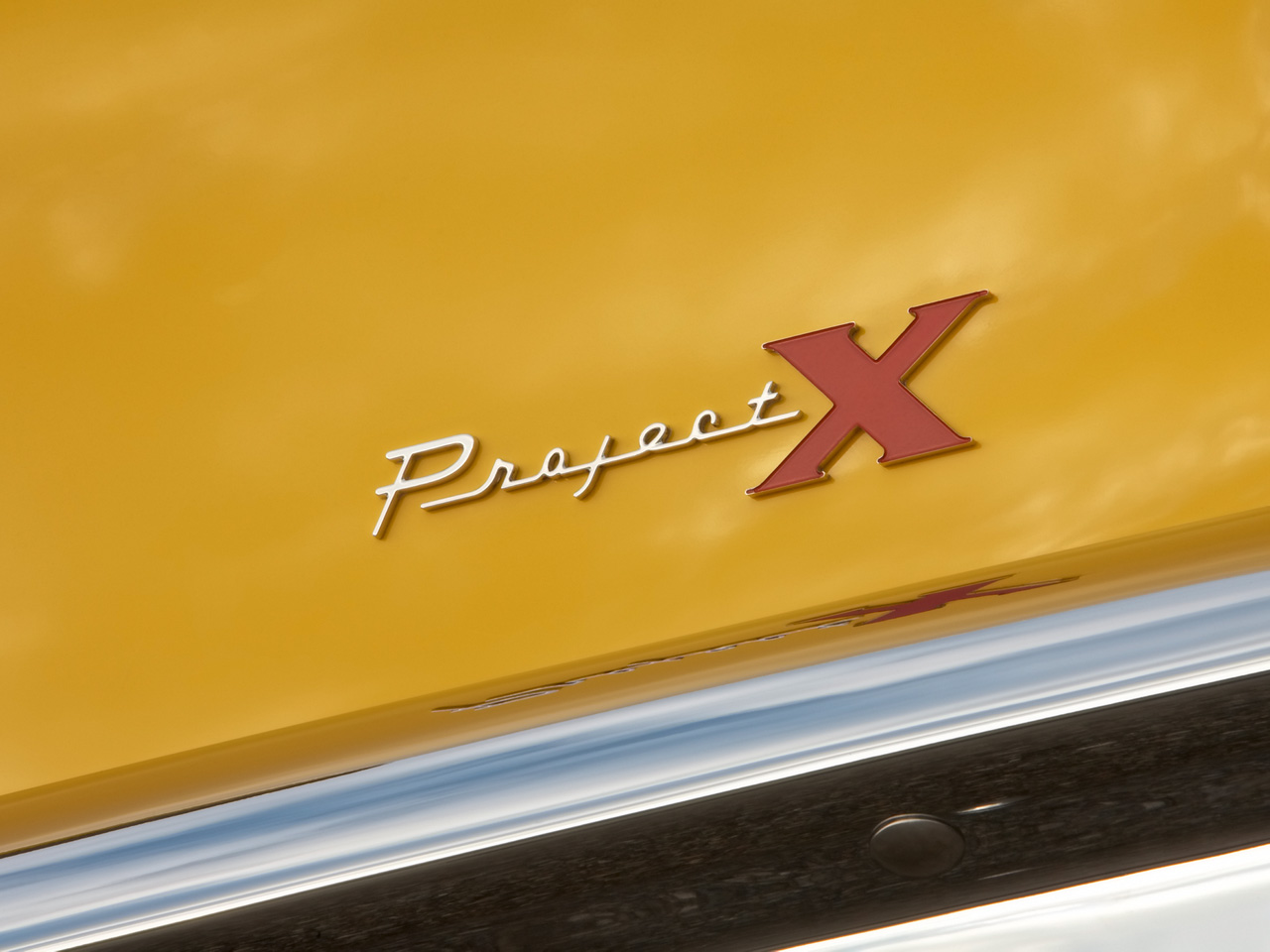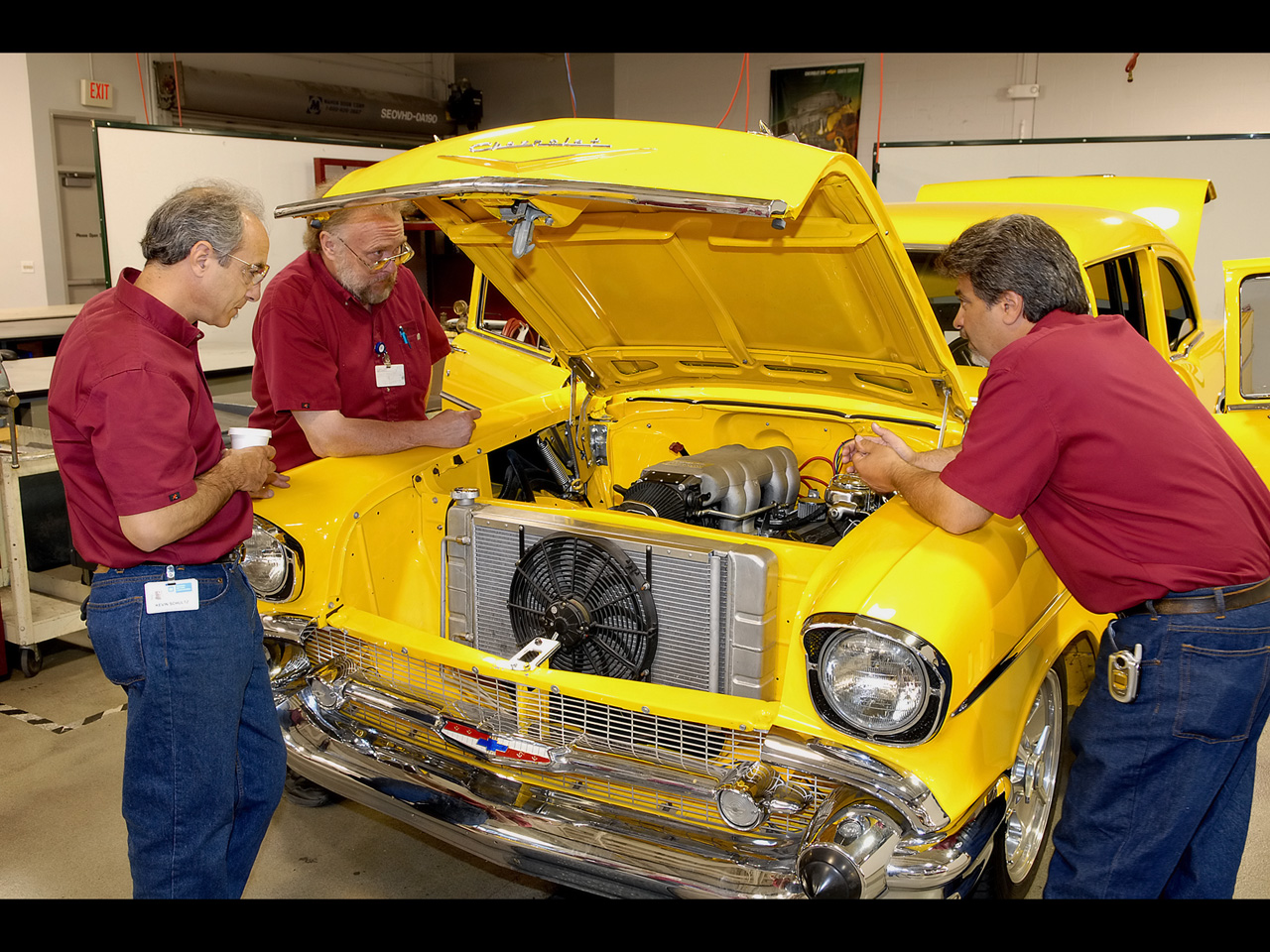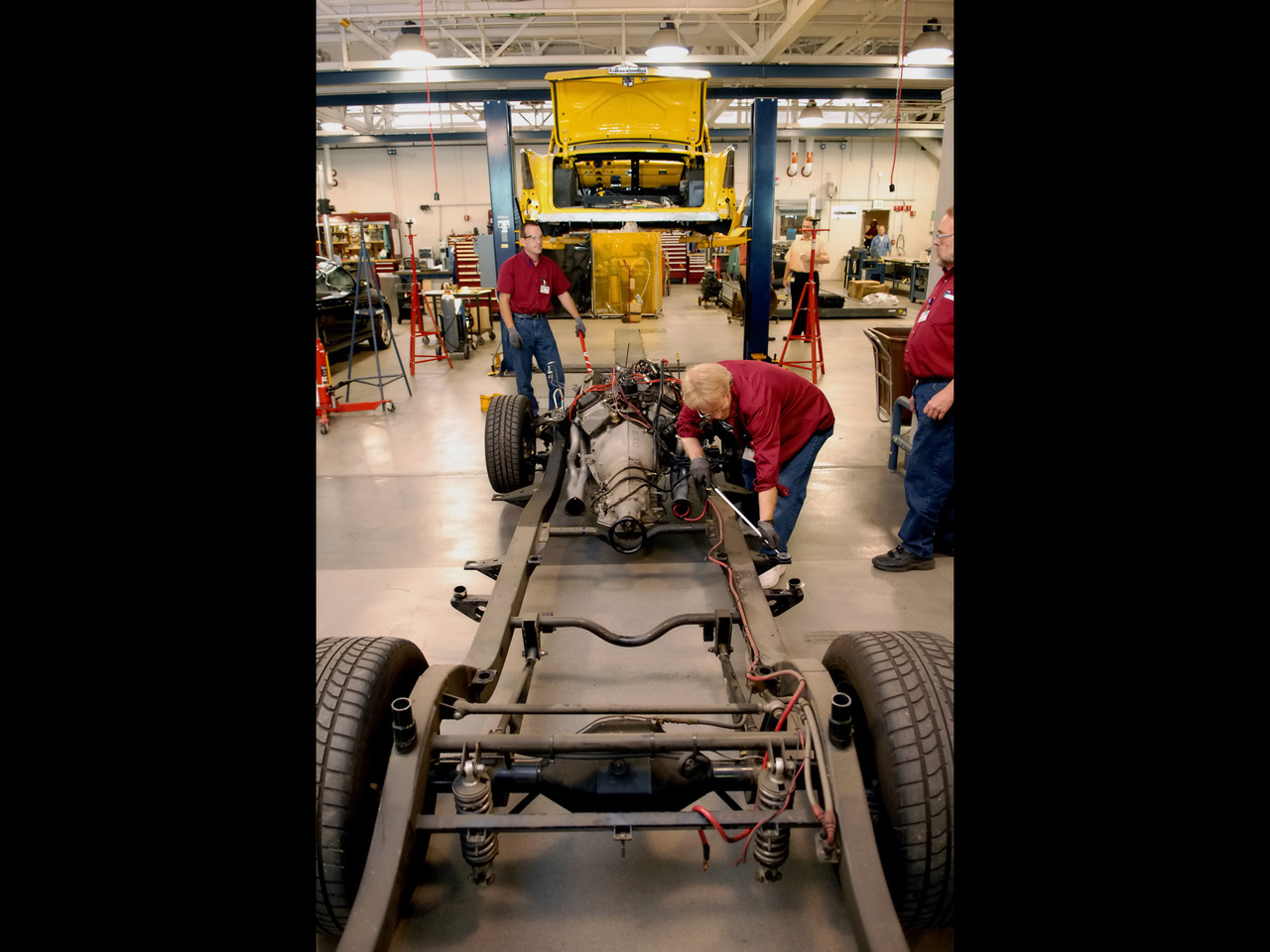1957 Chevrolet Project X
|
Price |
-- |
Production |
-- | ||
|
Engine |
7 liter V8 |
Weight |
-- | ||
|
Aspiration |
natural |
Torque |
450 lb-ft | ||
|
HP |
430 hp |
HP/Weight |
-- | ||
|
HP/Liter |
61.4 hp per liter |
1/4 mile |
-- | ||
|
0-62 mph |
-- |
Top Speed |
-- |
(from General Motors Press Release) ‘PROJECT X’ ’57 CHEVY IS REBORN WITH THE NEW GMPP ANNIVERSARY 427 ENGINE
It has been the subject
of more enthusiast magazine build stories than any other car and has
graced the cover of Popular Hot Rodding (PHR) countless times. It
even played a supporting role in “Hollywood Knights,” serving as the
supercharged transportation for Tony Danza and Michelle Pfeiffer.
The car is Project X, the most famous 1957 Chevy ever built – and
rebuilt. Since its debut in PHR more than 40 years ago, Project X
has served as a rolling, evolving test bed of high-performance parts
and a bell weather of automotive culture trends. But while this
perpetual project car has never absolutely been finished, it has
undergone several complete rebuilds – transformations that have
contemporized its performance and styling.
General Motors and PHR collaborated during the past year to
redesign, restore and re-power the iconic yellow shoebox, including
the first of a limited number of Anniversary 427 crate engines.
“General Motors is proud to have participated in its latest and most
extensive restoration ever,” said Al Oppenheiser, GM Performance
Division director for concept and vehicle integration. “This
completely ‘restified’ Chevy represents the ultimate form of Project
X.”
PHR entrusted Project X with GM Performance Division, which took the
car to its Warren, Mich., home for a frame-off revitalization. The
car was updated with a contemporary spin on the Pro Street theme,
with a modified Corvette front suspension, four-link and mini-tubbed
rear suspension and more.
“Working on Project X was like working on a time machine,” said Mike
Copeland, GM Performance Division project manager. “The history was
clear when we took it apart – there were remnants of past
modifications everywhere and the team members truly understood the
historical significance of the car.”
But while Project X has traditionally been a platform for
aftermarket performance, GM Performance Division restored it with a
great balance of O.E.M. parts and craftsmanship, complementing a
roster of components supplied by the performance industry’s top
manufacturers.
Anniversary 427
Nestled in at the front
of the frame rails is the all-new Anniversary 427 big-block crate
engine from GM Performance Parts. It is a modern re-creation of the
mythical, all-aluminum ZL-1 427 engine. It is underrated at 430
horsepower and 450 lb.-ft. of torque – like the production engine
was in 1969. Only 427 of the special engines will be built.
Production of the Anniversary 427 is based on the aluminum block’s
original tooling, which was thought to be lost after production of
the original ZL-1 engine halted in the early 1970s. GM Performance
Parts oversaw the refurbishment of the tooling and updated some
design features of the cylinder block, such as the addition of
screw-in galley plugs. The block casting also was strengthened in
key areas.
The Anniversary 427 has a 10:1 compression ratio, all-forged
reciprocating parts, a roller camshaft, aluminum oval-port heads
with 2.19/1.88-inch valves, HEI ignition and an 850-cfm four-barrel
carburetor mounted atop an aluminum dual-plane intake manifold. All
of the limited-edition engines come with natural-finish, “427
CHEVROLET”-script valve covers that are serialized, per their build
in the 427-unit run. Also, every engine comes with a matching-number
owner’s kit, adding to its exclusivity.
Exhaust exits the Anniversary 427 through custom headers that are
routed through the front fenders. They are connected to a
remote-activated cut-out switch that allows the gases to pass
through a conventional exhaust system to the rear of the car during
street driving, or through more direct, unrestricted openings behind
the front wheels.
Drivetrain details
Backing the Anniversary
427 in Project X is a heavy-duty Richmond five-speed manual
transmission, which channels torque to a Strange Engineering S60
rear axle that’s fitted with 3.73 gears. This all helps spin a set
of massive 20- x 15-inch rear wheels. Budnik built the one-off rims
for Project X, which melds period five-spoke styling with
contemporary proportions. They have satin-finished center sections
with polished outers, including the matching 18- x 7-inch front
wheels. The tires are from Mickey Thompson.
To hold up that heavy-duty drivetrain, while also ensuring safe,
comfortable and responsive driving performance, the GM Performance
team created a rear suspension featuring a triangulated four-link
design with QA-1 coil-over-shock components and Art Morrison control
arms. The rear frame rails were narrowed five inches to accommodate
the oversized tires.
At the front, sections of C6 Corvette rails are used. They were
spliced onto the Chevy’s original frame, enabling a complete
Corvette front suspension system to be used, including the disc
brake system with 14-inch rotors (Wilwood discs with 10-inch rotors
are used at the rear). A custom front stabilizer bar was created for
the car by Addco.
Enhanced structure
The Corvette suspension
provides Project X with vastly improved ride and handling
characteristics – attributes that were enhanced with a strengthened
front-end structure.
“Before starting the work, the car’s frame was scanned into our
computers for analysis,” said Copeland. “Although it was obvious
where opportunities existed for strengthening the front of the car,
the analysis helped determine the best way of achieving that goal.”
GM Performance Division engineers and technicians added a new
subframe and reconstructed the core support area at the front of the
chassis, while also adding structure to other sections of the
Project X’s front end – including an pair of additional body mounts.
The new core support structure also integrates a custom Griffin
radiator and the condenser for the Vintage Air climate system.
To free up more space under the hood – and prevent the classic Chevy
headache caused by the bulky latch – the stock hood latch was
replaced with Solstice latches. Also, the stock hood hinges were
swapped for Cadillac STS trunk hinges and hydraulic support lifts.
Body and paint
Like so many of the
details throughout the car, the body and paint work look simple
enough at a glance, but represent untold hours of planning,
execution and attention to detail.
The body was removed from the frame during the restoration and
completely reworked. At the front, the iconic bumper/grille was
re-done with a custom, billet aluminum grille bar – outfitted with a
“427” emblem – while the grille has a unique mesh pattern.
On the hood, the iconic “gun sight” ornaments were removed and their
housings enlarged by 50 mm. They now serve as ram air induction
inlets, feeding a custom air box mounted to the underside of the
hood. When the hood is closed, the air box fits over the Anniversary
427’s carburetor, which is fitted with an L-88-style flame arrestor.
Along the flanks, the signature ’57 Chevy side trim has been
re-created in CNC-milled billet aluminum. In fact, the rear trim
section – which was comprised of three pieces originally – was
reproduced as a single piece that more than seven feet long. And
though Project X is a “210” model, the builders “filled in” the rear
trim section with a stylized version of the Bel Air insert
incorporating countless brushed-style “X” insignias.
“There are countless details in the body and it really takes an
expert to find all of them,” said Copeland. “For example, the front
door corners were rounded off and the bumper bolts were removed for
a smoother look – even the small front fender slots were recreated
to match the angle of the headlamp housings.”
And because Project X has been yellow since its inception, it was
re-sprayed with a new Corvette Z06 Millennium Yellow hue.
Hidden amenities
As with the exterior,
Project X’s cabin was completely dismantled and rebuilt – with
plenty of subtle details and tricks. The dashboard, for example, was
custom-built with billet aluminum inserts that carry the same “X”
logos as the exterior Bel Air trim panel. A full set of Custom Rod
Gauges instruments – built specifically for Project X – fills the
panel in front of the driver. The dashboard also houses factory air
conditioning vents that serve as outlets for the aftermarket Vintage
Air climate system.
The front seats began life as Cadillac STS units and were modified
to give them a chopped-down, slimmer look – including the removal of
the headrests. The rear seat is from a 1956 Buick and it was
modified with an aluminum center trim panel. All the seats are
covered in rich, black leather with grey cloth inserts.
Additional interior details include door panel trim that mimics the
design of the exterior trim, a sporty steering wheel from a 1963
Impala ss and a ’64 Impala center console that was widened to fit
the space between the late-model STS seats. Rising out of the
console is a classic Hurst shifter that is used to stir the Richmond
five-speed.
Some of Project X’s best interior details are hidden in plain sight,
including the power window switches. They’re connected to the
original-type manual window cranks, which require only a
quarter-turn to lower or raise the windows – giving the interior a
great blend of vintage style and modern technology. A Kenwood audio
system is also hidden in the interior and it is operated via an
overhead touch-screen control panel. The panel also contains
controls for the exhaust cut-outs, fog lights and trunk release.
Other hidden features are located in the trunk, which was re-done in
hand-formed steel – including the wide wheel “tubs” – and
incorporates side access panels for storage and to keep the
rear-mounted battery out of view.
Project X partners
Addco – custom front
stabilizer bar
Akzo Nobel – powder coat
American Auto Wire – vehicle wiring and harnesses
Art Morrison – rear control arms
Budnik – custom wheels
classic Industries – 1963-64 Impala components (interior)
Custom Rod Gauges – dashboard instruments
Danchuk – 1957 Chevy restoration parts
DynoMax – 2.5-inch stainless steel mufflers
Experi-Metal – replacement sheet metal
Griffin – custom radiator
Hays – clutch
Hurst – shifter
Ididit – tilting steering column
Kenwood – audio system
Lakewood – transmission scatter shield
McLeod – hydraulic throw-out bearing
Mickey Thompson – tires
QA-1 – coil-over shocks
Richmond Gears – five-speed manual transmission
Royal Purple – engine oil and lubricants
Strange Engineering – S60 rear axle
Vintage Air – air conditioning system
|
|



